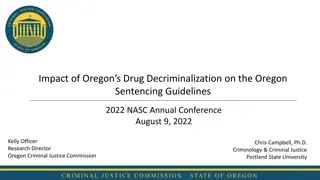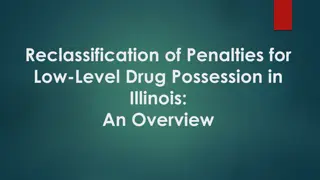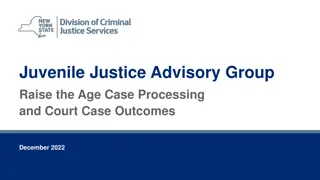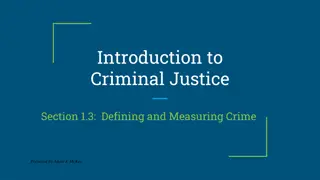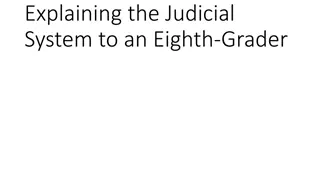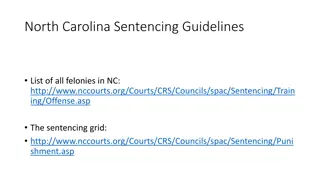Understanding Misdemeanors: Types, Consequences, and Impact on Society
Misdemeanors are crimes punishable by fines, jail time, or both, with varying degrees of severity. This article explores the differences between misdemeanors and felonies, provides examples of misdemeanors in Texas, outlines the consequences for defendants, including fines and potential jail time, a
1 views • 14 slides
Impact of Oregon's Drug Decriminalization on Sentencing Guidelines: Analysis from 2022 NASC Conference
Recent changes in Oregon's drug laws have led to significant reductions in arrests and convictions related to possession of controlled substances. These changes include shifting many drug offenses from felonies to misdemeanors, resulting in a drastic decrease in arrests and convictions since the imp
1 views • 19 slides
Reforming Penalties for Drug Possession in Illinois
Illinois is considering HB 3447 to reclassify penalties for low-level drug possession, shifting from felonies to misdemeanors. This overview explains the differences between felonies and misdemeanors, the impact of the proposed reform on various drugs, and how quantity affects penalties in drug poss
0 views • 26 slides
Common Grounds for Deportation in Criminal Cases Explained
Providing legal representation to immigrant clients in criminal cases involves understanding common deportation grounds such as felony vs. misdemeanor distinctions, crimes involving moral turpitude, aggravated felonies, and drug offenses. These grounds can impact an individual's immigration status,
2 views • 24 slides
Juvenile Justice Advisory Group: Raise the Age Case Outcomes December 2022
Beginning on Oct. 1, 2018, for 16-year-olds and Oct. 1, 2019, for 17-year-olds, the Raise the Age initiative led to significant changes in case processing and court outcomes for juvenile offenders in New York. Misdemeanors are now handled through Family Court delinquency procedures, and a Youth Part
1 views • 40 slides
Understanding Crime in the Criminal Justice System
This content delves into defining and measuring crime within the criminal justice system, discussing the types of crimes such as misdemeanors and felonies, alongside common law felonies and misdemeanors. It also highlights dual classifications of crimes and provides insight into the various offenses
0 views • 24 slides
Understanding the Judicial System in Simple Terms
In the judicial system, laws are created by elected officials to maintain order. City council members, county commissioners, and state legislators pass laws that define different crimes and their punishments, such as misdemeanors and felonies. These laws aim to ensure public safety and justice is se
0 views • 24 slides
Understanding Homicide: Types and Examples
Homicide is the killing of one human being by another, which can be criminal, noncriminal, or negligent. It may involve deliberate intent, malice, premeditation, and different degrees of murder like first and second degree. Examples include cases of first degree murder, second degree murder, and fel
0 views • 27 slides
Analysis of Sentencing Guidelines for Felonies and Homicide in North Carolina
Explore North Carolina's sentencing guidelines for felonies and different types of homicide, including punishments for crimes such as first-degree murder, manslaughter, and assault. Delve into a ranking exercise to assess which crimes may be perceived as most deserving of the death penalty based on
0 views • 14 slides
DACA Renewal Training Materials: Understanding Deferred Action and Prosecutorial Discretion
DACA Renewal Training Materials by Prerna Lal provides detailed information on Deferred Action for Childhood Arrivals (DACA), prosecutorial discretion, eligibility criteria for DACA, and definitions of felonies, significant misdemeanors, and non-significant misdemeanors. This resource aims to educat
0 views • 17 slides

